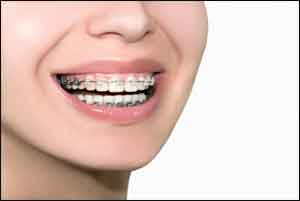- Home
- Editorial
- News
- Practice Guidelines
- Anesthesiology Guidelines
- Cancer Guidelines
- Cardiac Sciences Guidelines
- Critical Care Guidelines
- Dentistry Guidelines
- Dermatology Guidelines
- Diabetes and Endo Guidelines
- Diagnostics Guidelines
- ENT Guidelines
- Featured Practice Guidelines
- Gastroenterology Guidelines
- Geriatrics Guidelines
- Medicine Guidelines
- Nephrology Guidelines
- Neurosciences Guidelines
- Obs and Gynae Guidelines
- Ophthalmology Guidelines
- Orthopaedics Guidelines
- Paediatrics Guidelines
- Psychiatry Guidelines
- Pulmonology Guidelines
- Radiology Guidelines
- Surgery Guidelines
- Urology Guidelines
Adhesives developed to prevent bracket stains on teeth

Researchers from Valencia (Spain), London (England) and Sul (Brazil) have performed research to develop adhesive materials that will prevent white stains from appearing on the teeth of people who use brackets.
The white stains that orthodontic brackets often leave on teeth is a result of enamel demineralization caused by bacterial proliferation in the adhesive area, specially when accompanied by inadequate oral hygiene. Researchers at the Odontology Department of Valencia’s Universidad CEU Cardenal Herrera in collaboration with the King’s College London Dental Institute and the Universidade Federaldo Rio Grande do Sul (Brazil) have compared the efficacy of three new types of experimental adhesives, with bactericidal and enamel remineralisation properties which could prevent the appearance of these white stains around the brackets.
The research by CEU UCH Odontology teachers Salvatore Sauro and Santiago Arias in collaboration with the Universidade Federal do Rio Grande do Sul and the King’s College London Dental Institute, where Salvatore Sauro is an honorary professor, has been published in the Journal of Dentistry scientific magazine, one of the most prestigious in the field on an international level.
Bactericidal and remineralisation properties
The study compares three experimental dental adhesives which contain a bioactive nano-mineral called halloysite and whose nanotubes have been loaded with triclosan, a strong antibacterial and fungicidal agent in different concentrations: 5, 10 and 20 percent. The research compares the three new, experimental biomaterials’ polymerisation properties, their antibacterial strength and bioactive properties, which not only prevent demineralization of the teeth, but also promote remineralisation.
The three experimental materials tested in the laboratory have demonstrated an ability to stop bacterial proliferation in the 24 hours following their use, but only the one with the highest concentration of triclosan, at 20 per cent, has maintained this property after 72 hours. As far as the remineralising effect, all three tested materials have proven to be effective two weeks after their use in dental enamel samples submerged in experimental saliva.
These results are a promising step forward in the development of new adhesives that are capable of preventing the appearance of the bacteria that demineralise the enamel surrounding the brackets and, at the same time, remineralise the area and thus prevent the appearance of white stains on the teeth.
Research team
Professor Salvatore Sauro leads the Investigation Groups of the CEU-UCH in solid dental tissue engineering in situ and minimally invasive adhesive therapeutic rehabilitation. He has performed ample research on the development of new biomaterials with therapeutic properties and to aid dental remineralisation. CEU UCH Odontology Department professor Santiago Arias Luxan is the chief researcher of the university’s Orthodontics and Dentofacial Orthopedics Group, where he manages the Master’s Degree on this subject and teaches Orthodontics III and IV, an area he also dedicates much of his professional practice work to.
To read the article click on the link below.
https://www.sciencedirect.com/science/article/pii/S0300571217302695
bioactive nano-mineralbracket stainsbracketsenamel demineralizationfungicidal agenthalloysiteorthodontic bracketsteethTriclosanwhite stains
Source : Press ReleaseNext Story
NO DATA FOUND

Disclaimer: This site is primarily intended for healthcare professionals. Any content/information on this website does not replace the advice of medical and/or health professionals and should not be construed as medical/diagnostic advice/endorsement or prescription. Use of this site is subject to our terms of use, privacy policy, advertisement policy. © 2020 Minerva Medical Treatment Pvt Ltd